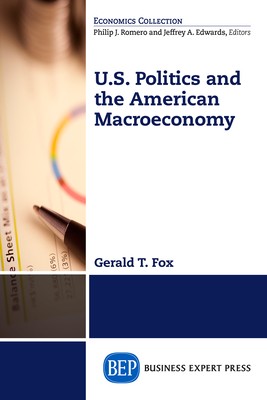
- We will send in 10–14 business days.
- Author: Gerald T Fox
- Publisher: Business Expert Press
- ISBN-10: 1606495321
- ISBN-13: 9781606495322
- Format: 15.2 x 22.9 x 1.1 cm, minkšti viršeliai
- Language: English
- SAVE -10% with code: EXTRA
Reviews
Description
This book considers the interrelation among macroeconomic politics, macroeconomic policymakers, macroeconomic policies, and macroeconomic perform ance. This interaction is examined using the expectational Phillips curve model, which measures macroeconomic outcomes in terms of inflation and unemployment. The subject of macroeconomic politics mainly focuses on voter behavior, presidential re-election ambition, and political party priorities. These political factors influence the macroeconomic policy actions of the president, Congress, and the central bank; the analysis takes into account both fiscal and monetary policies. The author's examination of citizen sentiment is based on rational voter theory and the median voter model. He compares the effects of macroeconomic farsightedness versus shortsightedness in voters and contrasts the conservative versus liberal perspectives on macroeconomic policy and performance. The empirical component of the analysis examines the electoral and partisan political business cycle effects upon the U.S. economy, and evidence of idiosyncratic effects during the time frame of 1961-2014 is found. Finally, the author discusses macroeconomic influence on various measures of voter sentiment, such as presidential job approval, and presidential and congressional election outcomes.
EXTRA 10 % discount with code: EXTRA
The promotion ends in 21d.23:52:31
The discount code is valid when purchasing from 10 €. Discounts do not stack.
- Author: Gerald T Fox
- Publisher: Business Expert Press
- ISBN-10: 1606495321
- ISBN-13: 9781606495322
- Format: 15.2 x 22.9 x 1.1 cm, minkšti viršeliai
- Language: English English
This book considers the interrelation among macroeconomic politics, macroeconomic policymakers, macroeconomic policies, and macroeconomic perform ance. This interaction is examined using the expectational Phillips curve model, which measures macroeconomic outcomes in terms of inflation and unemployment. The subject of macroeconomic politics mainly focuses on voter behavior, presidential re-election ambition, and political party priorities. These political factors influence the macroeconomic policy actions of the president, Congress, and the central bank; the analysis takes into account both fiscal and monetary policies. The author's examination of citizen sentiment is based on rational voter theory and the median voter model. He compares the effects of macroeconomic farsightedness versus shortsightedness in voters and contrasts the conservative versus liberal perspectives on macroeconomic policy and performance. The empirical component of the analysis examines the electoral and partisan political business cycle effects upon the U.S. economy, and evidence of idiosyncratic effects during the time frame of 1961-2014 is found. Finally, the author discusses macroeconomic influence on various measures of voter sentiment, such as presidential job approval, and presidential and congressional election outcomes.


Reviews